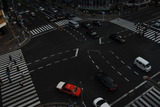
An example of how to calculate the crash rate for an intersection
- Subject:
- Algebra
- Engineering
- Material Type:
- Activity/Lab
- Homework/Assignment
- Author:
- Peyton Ratto
- Date Added:
- 12/14/2021

An example of how to calculate the crash rate for an intersection
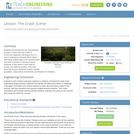
In this lesson, students find their location on a map using Latitude and Longitudinal coordinates. They determine where they should go to be rescued and how best to get there.

You are preparing your family’s emergency kits in case there is a need to leave your home quickly, or stay in your home without electricity or water. You need to be able to create an emergency supply kit that includes a lightweight water filtration device that is low cost. This will provide you with clean water regardless of your water source.
In this project, you will gain knowledge of natural disaster preparedness through the Red Cross Pillowcase project. You will research and experiment with the water cycle to learn how water is naturally filtered. You will then design and build a water filtration device that could filter water in an emergency situation.
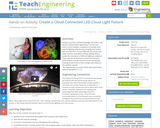
Students put their STEAM knowledge and skills to the test by creating indoor light fixture “clouds” that mimic current weather conditions or provide other colorful lighting schemes they program and control with smartphones. Groups fabricate the clouds from paper lanterns and pillow stuffing, adding LEDs to enable the simulation of different lighting conditions. They code the controls and connect the clouds to smart devices and the Internet cloud to bring their floating clouds to life as they change color based on the weather outside.
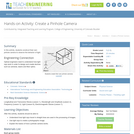
In this activity, students construct their own pinhole camera to observe the behavior of light.
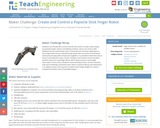
Students are introduced to servos and the flex sensor as they create simple, one-jointed, finger robots controlled by Arduino. Servos are motors with feedback and are extensively used in industrial and consumer applications—from large industrial car-manufacturing robots that use servos to hold heavy metal and precisely weld components together, to prosthetic hands that rely on servos to provide fine motor control. Students use Arduino microcontrollers and flex sensors to read finger flexes, which they process to send angle information to the servos. Students create working circuits; use the constrain, map and smoothing commands; learn what is meant by library and abstraction in a coding context; and may even combine team finger designs to create a complete prosthetic hand of bendable fingers.
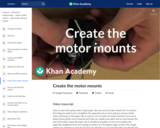
Creating motor mounts. Created by Karl Wendt.
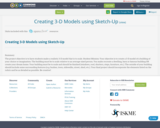
The project objective is to have students make a realistic 3-D model that is to scale. Student Mission: Your objective is to create a 3-D model of a building of your choice or imagination. The building must be to scale relative to an average-sized person. You make recreate a dwelling, barn or famous building OR create your dream home. Your building must be to scale and should be finished (windows, roof, shutters, steps, furniture, etc.). The outside of your building should include some surrounding features (e.g. bushes, trees, sidewalks, street, shed, etc.). Your final project should incorporate the elements listed on the rubric and be as detailed as possible. Be creative!
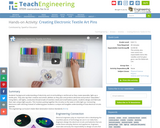
Students’ background understanding of electricity and circuit-building is reinforced as they create wearable, light-up e-textile pins. They also tap their creative and artistic abilities as they plan and produce attractive end product “wearables.” Using fabric, LED lights, conductive thread (made of stainless steel) and small battery packs, students design and fabricate their own unique light-up pins. This involves putting together the circuitry so the sewn-in LEDs light up. Connecting electronics with stitching instead of soldering gives students a unique and tangible understanding of how electrical circuits operate.
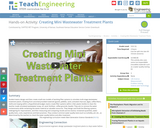
Student teams design and then create small-size models of working filter systems to simulate multi-stage wastewater treatment plants. Drawing from assorted provided materials (gravel, pebbles, sand, activated charcoal, algae, coffee filters, cloth) and staying within a (hypothetical) budget, teams create filter systems within 2-liter plastic bottles to clean the teacher-made simulated wastewater (soap, oil, sand, fertilizer, coffee grounds, beads). They aim to remove the water contaminants while reclaiming the waste material as valuable resources. They design and build the filtering systems, redesigning for improvement, and then measuring and comparing results (across teams): reclaimed quantities, water quality tests, costs, experiences and best practices. They conduct common water quality tests (such as turbidity, pH, etc., as determined by the teacher) to check the water quality before and after treatment.
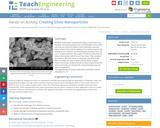
Students create silver nanoparticles using a chemical process; however, since these particles are not observable to the naked eye, they use empirical evidence and reasoning to discover them. Students first look for evidence of a chemical reaction by mixing various solutions and observing any reactions that may occur. Students discover that copper and tannic acids from tea reduce silver nitrate, which in turn form silver. They complete the reaction, allow the water to evaporate, and observe the silver nanoparticles they created in plastic dishes using a stereo microscope. Students iterate on their initial process and test to see if they can improve the manufacturing process of silver nanoparticles.

CMS.611J / 6.073 Creating Video Games is a class that introduces students to the complexities of working in small, multidisciplinary teams to develop video games. Students will learn creative design and production methods, working together in small teams to design, develop, and thoroughly test their own original digital games. Design iteration across all aspects of video game development (game design, audio design, visual aesthetics, fiction and programming) will be stressed. Students will also be required to focus test their games, and will need to support and challenge their game design decisions with appropriate focus testing and data analysis.
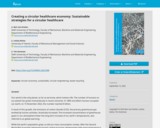
Our world is the only planet, as far as we know, which harbors life. The number of humans on our planet has grown tremendously in recent centuries. In 1800 one billion humans occupied our earth; on 15 November 2022, this number reached 8 billion.
A result of this growth, the emissions of carbon dioxide (CO2), the primary greenhouse gas emitted by human activities, drastically increased. The increased concentrations of greenhouse gases in our atmosphere foster the long-term increase of our earth’s temperatures, also referred to as global warming.
While the earth’s population grew, so did our mass consumption society. After the Second World War humanity witnessed gigantic global economic development with great technological improvements. Computers, laptops, airplanes, tablets and Internet of Things connected humans all over the world. The hunger for plastics and steel grew as all products had to be manufactured in ever-increasing volumes. As the economy developed, our consumption grew apace.
The healthcare sector has seen the same increase of consumption. The number of patients grew, and so did the number of single-use medical products. As products become more complex and more different materials were combined., recycling became more difficult. Thus, hospitals transformed into waste factories with ever-growing waste streams. The consumption of (disposable) medical devices takes up scarce raw materials and contributes to the growing CO2 emissions.
In this book, Van Straten, Alvino and Horeman present their findings on how to create a sustainable healthcare economy by introducing different circular strategies. In 9 chapters, they present a wide variation of studies as practical cases to show what strategies and actions can be taken in order to implement sustainable strategies for a circular healthcare.
This book was written in line with the courses the authors developed at TU Extension School, the open online education edX platform of Delft University of Technology/TU Delft, a leading university in science and technology, recognized for its world-class research. This book is a manual for everyone who follows the online course ‘Circular strategies for a sustainable healthcare’, but certainly also for everyone who wants to discover more about circular strategies and wants to understand the principles and practices of circular economy and urban mining. This book is suitable for students, researchers, policymakers and practitioners in the fields of healthcare sustainability, management, business and economics.
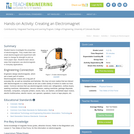
Student teams investigate the properties of electromagnets. They create their own small electromagnet and experiment with ways to change its strength to pick up more paper clips. Students learn about ways that engineers use electromagnets in everyday applications.

Can you code & utilize a Micro:bit to create a species counter to track local wildlife? Can you design a way to make it into a “wearable device”? Can you report the data and as a whole class discuss biodiversity?The goal of this project is to integrate the two together to make the technology more relevant and impactful. Biodiversity describes the variety of species found in Earth’s terrestrial and oceanic ecosystems. The completeness or integrity of an ecosystem’s biodiversity is often used as a measure of its health. Why is diversity important in an ecosystem?
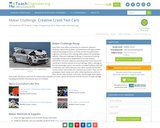
Finding the relationship between mass and momentum.
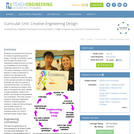
Students are introduced to the world of creative engineering product design. Through six activities, teams work through the steps of the engineering design process (or loop) by completing an actual design challenge presented in six steps. The project challenge is left up to the teacher or class to determine; it might be one decided by the teacher, brainstormed with the class, or the example provided (to design a prosthetic arm that can perform a mechanical function). As students begin by defining the problem, they learn to recognize the need, identify a target population, relate to the project, and identify its requirements and constraints. Then they conduct research, brainstorm alternative solutions, evaluate possible solutions, create and test prototypes, and consider issues for manufacturing. See the Unit Schedule section for a list of example design project topics.
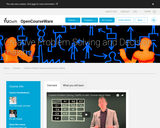
Explore complex, multi-actor systems in which one factor influences all other factors. For instance, how innovative energy technologies merge into the existing energy system, or how new transport possibilities impact current processes. Armed with this information, learn to decide whether they should be further developed, consider possible negative results and weigh associated costs.
There are multiple ways to make decisions, but one way proven to be very useful is the analytical approach – a methodology for making the problem explicit and rationalising the different potential solutions. In short: analysis based support of decision making, design and implementation of solutions.
Creative Problem Solving and Decision Making as a course teaches you this method.
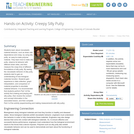
Students learn about viscoelastic material behavior, such as strain rate dependence and creep, by using silly putty, an easy-to-make polymer material. They learn how to make silly putty, observe its behavior with different strain rates, and then measure the creep time of different formulations of silly putty. By seeing the viscoelastic behavior of silly putty, students start to gain an understanding of how biological materials function. Students gain experience in data collection, graph interpretation, and comparison of material properties to elucidate material behavior. It is recommended that students perform Part 1of the activity first (making and playing with silly putty), then receive the content and concept information in the associated lesson, and then complete Part 2 of the activity (experimenting and making measurements with silly putty).
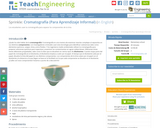
Los estudiantes usan la cromatografía para separar los componentes de la tinta.